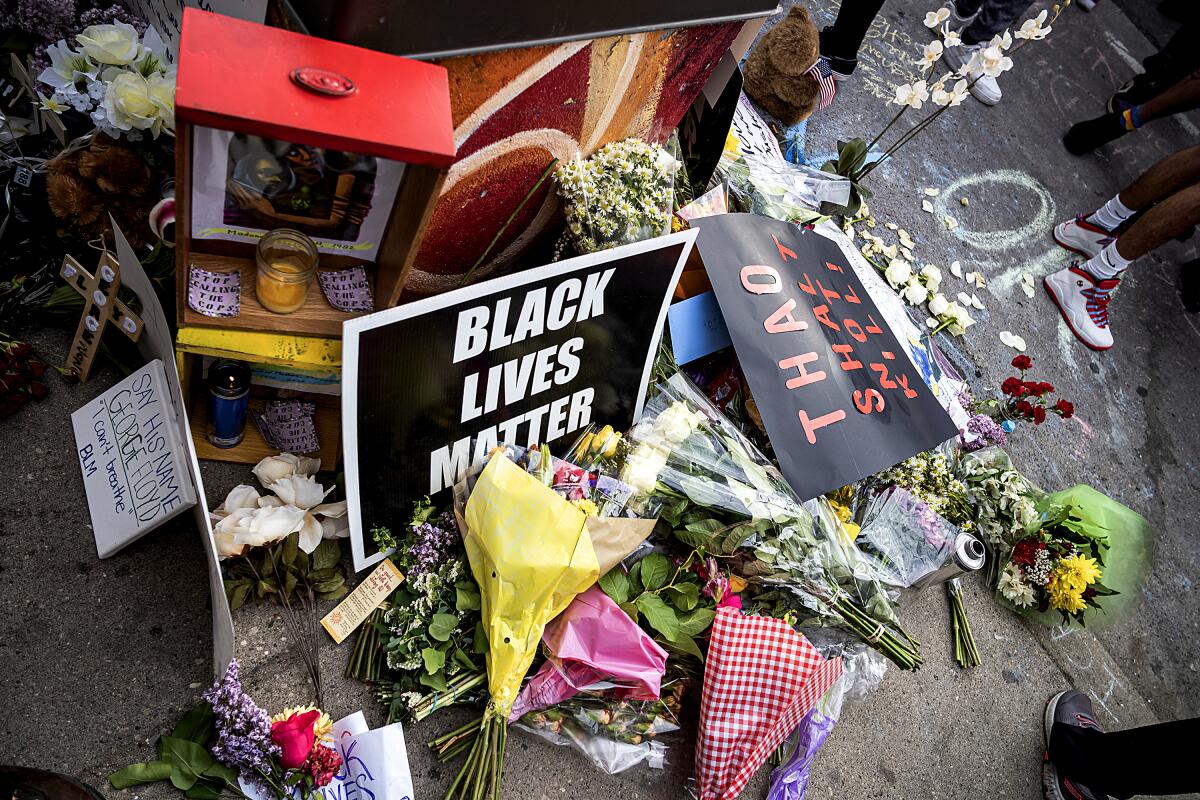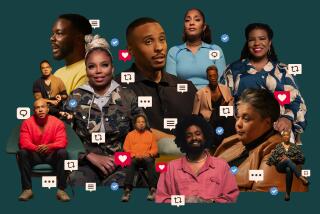Op-Ed: I’m a Black social media manager in the age of George Floyd. Each day is a new trauma

- Share via
Recently, as I scrolled the more than 1 million tweets connected to the hashtag #Black_Lives_Matter, this is what flashed before my eyes: the black-and-white dashcam video of Philando Castile’s girlfriend, Diamond Reynolds, in handcuffs crying, her 4-year-old daughter trying to comfort her; protesters in Berlin standing in solidarity with the BLM movement; a video of a young, Black girl calling herself ugly; police attacking protesters and protesters fighting back; an image of George Floyd unable to breathe.
Suddenly neither could I. My chest tightened, my heart beat faster and hot tears began to bubble from my eyes.
For a person of color, engaging in this moment of collective trauma — whether by watching and sharing the video of George Floyd’s death, discussing racial injustice on social media or speaking out in the physical world — involves anxiously teetering across the fine lines between personal experience, obligations to the community and — in my case — professional responsibilities. Since I manage a news organization’s social media platforms, it’s part of my job.
Many Americans describe watching the videos as a wake-up call to persistent racial injustice. For Black Americans it touches a deeper nerve, creating a form of vicarious trauma, said Ann Ebhojiaye, a psychotherapist in Baltimore.
The reaction is normal. “You’re seeing images and videos of violence against people that look like you and sometimes not being aware of what you’re experiencing,” she told me.
Recognizing that effect is important. Research suggests that repeated viewing of terrorism news coverage can lead to symptoms of post-traumatic stress disorder, especially in people who have previous exposure to violence. Yet the onslaught of distressing images is hard to escape.
These videos carry echoes of historical images of lynchings and public killings of Black people. “There is a long memory and expectation extending from slavery that Black suffering be public,” said Deidre Cooper Owens, a historian and the director of the Humanities in Medicine Program at the University of Nebraska.
But Cooper Owens does not call for censorship of images. Instead, she points to the gratuitous nature of their sharing as a problem. Why, she asked, should Black people be subject to “the overrepresentation of our trauma?”
Yet there’s little doubt that these kinds of videos helped to grow the Black Lives Matter movement into an urgent national protest. Their viral nature forced society and even the global community to witness the brutality so many wanted to deny.
As a social media manager, I wonder if those of us in this field should be doing more to help users navigate this traumatic moment.
If you type the word “suicide” into your Twitter search bar, you are immediately presented with an embedded message that reads “Help is available,” as well as a phone number and link to the National Suicide Prevention Lifeline website.
If sensitive content such as the video of Floyd’s death and countless others like it are allowed on social media platforms, why shouldn’t that content be flagged with additional support and resources?
“There is a general lack of understanding from the social media industry about the effects of repeatedly consuming disturbing content,” said C. Vaile Wright, senior director of healthcare innovation at the American Psychological Assn.
For instance, images that depict gratuitous gore and certain sexual content are not allowed on Twitter, but sensitive content such as the video of Floyd’s death do not break Twitter’s rules. They are allowed to appear on the platform, but they should appear with an interstitial — a filter that warns of sensitive content, and blurs the content until you click and agree to see it.
Video hashing tools are used across the social media industry to prevent re-uploads of violent videos, but they can’t stop re-uploads of versions that have been altered or edited. Likewise, the interstitial warnings may disappear when sensitive videos are edited and re-uploaded, as is the case with viral content, such as the killing of George Floyd.
One option is for users to adjust their safety settings on Twitter to block sensitive content and disable the autoplay function of videos on their timelines.
What we do know is that simply unplugging isn’t adequate advice for communities of color trying to cope with the effects of vicarious trauma. Sometimes, as Ebhojiaye said, “it’s important to really process, why are you so emotional?” When you have that awareness, you can work toward taking action in a way that you feel is empowering, she said.
For me, watching Floyd’s agonizing death caused me to confront the pain of a lifetime of digesting racist and colorist messaging that seemed to scream, “Your skin is too dark, your hair is too kinky, your voice does not matter, your life does not matter!”
Viewing that video and other images that assault people who look like me is part of my profession. It can be very hard to steel yourself against the pain you see.
For me, healing has involved reminding myself that I am both beautiful and worthy. That’s something I do through the art of storytelling, songwriting, performance art — and writing like this.
Chaseedaw Giles is a social media manager at Kaiser Health News, a nonprofit news service covering health issues. It is not affiliated with Kaiser Permanente.
More to Read
A cure for the common opinion
Get thought-provoking perspectives with our weekly newsletter.
You may occasionally receive promotional content from the Los Angeles Times.










